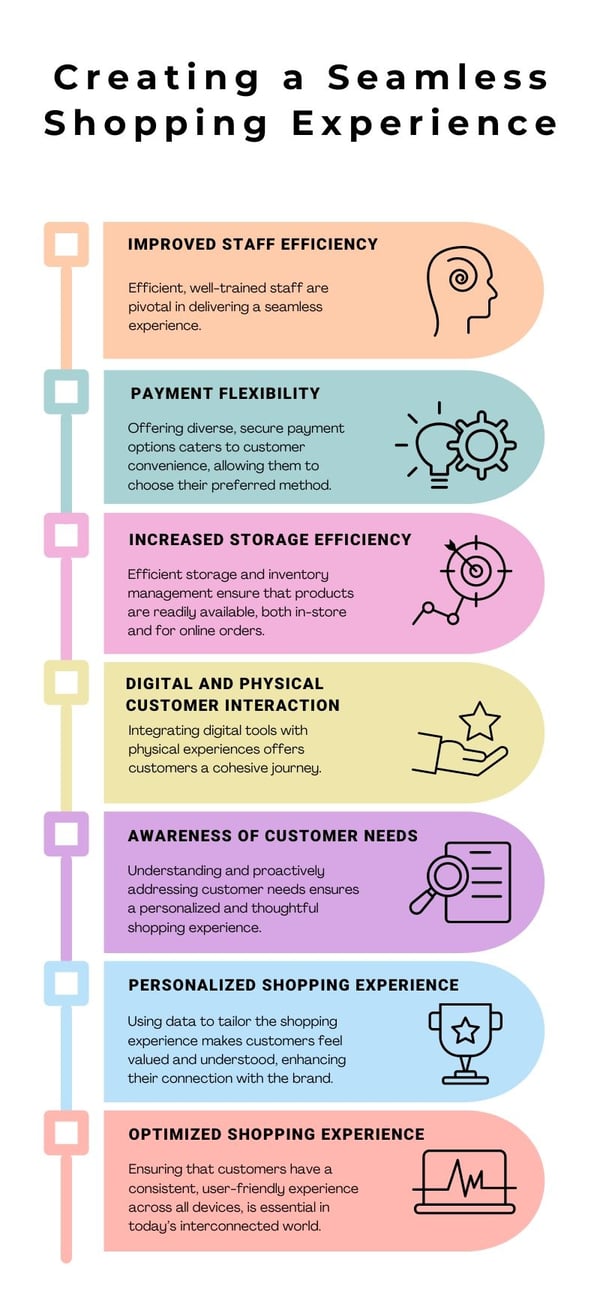In today's fast-paced world, customers expect shopping to be smooth and hassle-free, whether they're clicking through a website or strolling through store aisles. This article dives into what it means to provide a seamless shopping experience, a journey so fluid and convenient that it feels natural to the customer.
We'll explore key strategies like understanding every step of the customer's journey, using the right technology, and offering flexible payment options. These elements are crucial in transforming a simple purchase into a delightful and memorable shopping experience.
What does a Seamless Shopping Experience mean?
A seamless shopping experience represents an integrated, frictionless journey for customers across all channels and touchpoints with a brand. It transcends mere transactions to offer a consistent, engaging, and convenient interaction from the initial point of contact, through the purchase process, to post-sale support.
This approach focuses on understanding and meeting customer needs, minimizing delays, and ensuring convenience and satisfaction at every stage. It leverages technology, staff training, and operational excellence to create a unified experience, whether the customer shops online, in-store, or through a combination of channels. A seamless experience is intuitive, anticipates customer needs, and provides personalized interaction, ensuring that every step feels natural, efficient, and tailored to individual preferences. The goal is to make shopping effortless, enjoyable, and memorable, encouraging repeat business and fostering brand loyalty.
Examples of a Seamless Shopping Experience
Nike's In-Store Experience
Nike takes the seamless experience into the physical realm with its innovative stores. For instance, the Nike Live concept store in Los Angeles uses data from local users' app activity to stock its shelves, effectively tailoring the store's inventory to the preferences of the local community. Additionally, customers can reserve shoes online to try them on in-store, and the Nike App at Retail allows customers to scan QR codes on mannequins to see and shop for items available in their size.
Sephora's Virtual Artist
Sephora offers a seamless and personalized shopping experience with its Virtual Artist app feature, where customers can try on different makeup products virtually using their phone's camera. This not only enhances the shopping experience by allowing customers to experiment with products before buying but also bridges the gap between the digital and physical shopping realms.
Walmart's Pickup and Delivery
Walmart has streamlined the shopping experience with its pickup and delivery services. Customers can shop for groceries and a wide range of products online or via the Walmart app and have the option to pick up their orders curbside at a pre-scheduled time or get them delivered to their doorstep. This service merges the convenience of online shopping with the immediacy of physical retail.
Apple's Seamless Ecosystem
Apple provides a seamless shopping experience through its ecosystem of devices and services. Customers can start shopping on one device, like an iPhone or iPad, and finish on another, like a Mac, without any interruption. The integration of Apple Pay across devices also makes the purchasing process incredibly smooth and secure, enhancing the overall shopping experience.
Advantages of a Seamless Shopping Experience
A seamless shopping experience elevates customer satisfaction, fostering loyalty and encouraging repeat business. It streamlines the purchase journey, reducing friction and potentially increasing conversion rates. This approach differentiates a brand in a crowded market, enhancing its reputation and attracting new customers through positive word-of-mouth.
A seamless experience also enables efficient data collection, providing insights into customer preferences and behavior, which can be leveraged to personalize interactions, refine marketing strategies, and develop targeted promotions. It leads to operational efficiency, as integrated systems and processes reduce errors and save time. In an era where customer expectations are high, offering a seamless experience is not just an advantage but a necessity for businesses aiming to thrive in a competitive landscape.
What makes a Customer Shopping Experience Seamless

Improved Staff Efficiency
Efficient, well-trained staff are pivotal in delivering a seamless experience. They ensure swift, knowledgeable service, and can adeptly use technology to enhance customer interactions, reducing wait times and ensuring customer needs are promptly met.
Payment Flexibility
Offering diverse, secure payment options caters to customer convenience, allowing them to choose their preferred method. This flexibility, coupled with a smooth, quick transaction process, enhances the overall shopping experience.
Increased Storage Efficiency
Efficient storage and inventory management ensure that products are readily available, both in-store and for online orders. This minimizes wait times for customers and ensures a smooth, uninterrupted shopping journey.
Digital and Physical Customer Interaction
Integrating digital tools with physical experiences offers customers a cohesive journey. Whether using an app in-store or interacting with digital catalogs, these touchpoints enrich the shopping experience and provide valuable information and convenience.
Awareness of customer needs
Understanding and proactively addressing customer needs ensures a personalized and thoughtful shopping experience. This can mean anticipating common questions, providing clear information, or ensuring staff are attentive and responsive.
Personalized shopping experience based on past behavior and preferences
Using data to tailor the shopping experience, like personalized recommendations or remembering previous preferences, makes customers feel valued and understood, enhancing their connection with the brand.
Optimised shopping experience across multiple devices
Ensuring that customers have a consistent, user-friendly experience across all devices, whether they're using a mobile, tablet, or desktop, is essential in today’s interconnected world.
Tips to Create a Seamless Shopping Experience
Creating a seamless shopping experience is about understanding and catering to customer needs at every interaction. Here are a few tips and tricks to create this type of experience for your shoppers:
Identify Customer Touchpoints
In-Depth Approach: Map the customer journey meticulously, identifying all potential touchpoints – from initial awareness (ads, social media) to post-purchase support (customer service, follow-up emails).
Optimization Strategy: Assess each touchpoint for its effectiveness and ease. For instance, ensure your website's UI/UX is intuitive, and in-store interactions are customer-friendly. Regularly update and refine these touchpoints based on customer feedback and changing trends.
Track Customer Metrics
Comprehensive Analytics: Dive deep into metrics that reflect customer satisfaction and loyalty. Use tools like NPS (Net Promoter Score), CSAT (Customer Satisfaction Score), and CES (Customer Effort Score) to gauge sentiment.
Actionable Insights: Analyze patterns and trends in the data to understand customer behavior better. Tailor your services or products based on these insights to improve the overall customer experience.
Invest in the Right Technology
Technology Alignment: Implement technology solutions that streamline and enhance the customer journey. For example, a CRM system can provide insights into customer preferences, while AI-driven chatbots can offer instant customer support.
Continuous Improvement: Regularly update your technology stack to keep up with advancements and ensure all systems integrate seamlessly to provide a uniform customer experience.
Improve Mobile Experience
Mobile Optimization: Ensure your website and apps are mobile-friendly, with responsive design and quick loading times. Consider features like one-touch payment and easy navigation to enhance the mobile shopping experience.
Ongoing Testing: Regularly test your mobile platforms for user-friendliness. Use A/B testing for different features and gather user feedback to continually refine the mobile experience.
Offer Seamless Payment Options
Diverse Payment Solutions: Integrate multiple payment options to cater to different customer preferences. This could include credit cards, digital wallets, and in some cases, even cryptocurrency.
Frictionless Checkout: Simplify the checkout process. Reduce the number of steps, offer guest checkout options, and ensure transparency in costs (shipping, taxes) to minimize surprises and reduce cart abandonment.
Summing up
Offering a seamless shopping experience is about ensuring every part of the customer's journey is smooth and effortless. It's not just about selling products but about creating a shopping journey that feels personal and effortless.
By focusing on the details, from how customers interact with your brand to the technology you use and the payment options you offer, you can turn shopping into a seamless and enjoyable journey. In a world where everyone is busy, making shopping easier and more pleasant isn't just good for customers, it's essential for businesses that want to stay ahead and be remembered.



